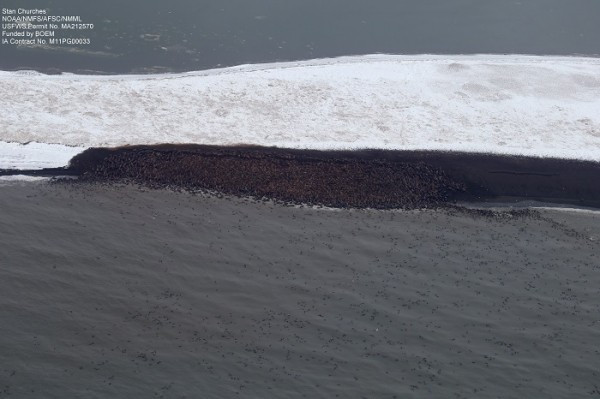10,000-Strong Walrus Army Storm Alaska Beach

A herd of around 10,000 walruses has come ashore a beach in Alaska because of the lack of sea ice in the Arctic.
The walrus army appeared on a beach on a barrier island near Point Lay, an Inupiat Eskimo village on Alaska's northwest coast last week.
The National Oceanic and Atmospheric Administration photographed the herd after spotting it during the annual arctic marine mammal aerial survey.
In the middle of last month, the US Fish and Wildlife Service, which manages walruses, reported that up to 4,000 had appeared at the site and had taken efforts to prevent a stampede among the animals, which were packed shoulder to shoulder along the coastline, in order to protect villagers and young members of the herd.
However, the latest walrus gathering is believed to be a result of the loss of summer sea ice due to global warming.
Huge numbers of walruses were first spotted on the coast of the Chukchi sea in 2007. They returned to the site in 2009 and again in 2011.
At one point 30,000 walruses were stationed on just one kilometre of beach in Point Lay.

Limited foraging
Environmental groups say the loss of sea ice is harming marine mammals, with oil and gas developments adding to the stress placed on their habitat.
The loss of sea ice affects walrus distribution and feeding opportunities. They use sea ice as a stable yet drifting platform for rest between foraging trips, as well as calving and traveling.
A reduction in sea ice means walruses will spend more time on shore haulouts, meaning foraging trips are more limited to nearby grounds. This close proximity also results in stampedes, which kill many calves that get crushed in the process.
The marine mammals survey is an attempt to record the abundance of animals in areas of potential oil and natural gas development.
"In addition to photographing the walrus haulout area, NOAA scientists documented more bowhead whales, including calves and feeding adults in the Beaufort Sea this summer compared to 2012," said NOAA Fisheries marine mammal scientist Megan Ferguson.
"We are also seeing more gray whale calves in the Chukchi Sea than we have in recent years."
© Copyright IBTimes 2025. All rights reserved.




















